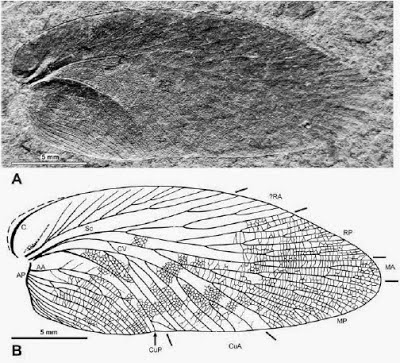Despite being considered ubiquitous urban pests in many parts of the
world, Cockroaches, Blattaria, are one of the smallest groups of extant
Insects, with only about 5000 described living species. On the other hand the
group have a long fossil record, dating back to the Palaeozoic, and modern
Cockroaches are an extremely diverse group, with eusocial, jumping, aquatic,
pollinating, troglobitic (cave dwelling) and bioluminescent species all known,
suggesting modern Cockroaches may be relicts of a much more diverse group.
In a paper published in the journal Palaeontologica Electronica in
April 2015, Dale Greenwalt of the Department of Paleobiology at the National Museum of Natural History and Ľubomír Vidlička of the Instituteof Zoology at the Slovak Academy of Sciences and the Department of Zoology at ComeniusUniversity describe a new species of
fossil Cockroach from the Middle Eocene Kishenehn Formation of northwestern Montana.
The new species is placed in the modern genus Latiblattella and given the specific name avita, meaning ancient or ancestral. The specimen comprises a
forewing and leg preserved on a piece of oil-shale recovered from the Dakin
Site on the Middle Fork of the Flathead Rivernear Pinnacle, Montana. The forewing is 15.1 mm in length,
and as with many Insect groups Cockroaches are typically classified by the
venation of their wings, so Greenwalt and Vidlička are confident with the
assignment of the fossil.
Latiblattella avita.Tegmen (forewing) attached (?) to an intact middle leg. Scale bar
equals 5 mm. Greenwalt & Vidlička (2015).
Modern members of the genus Latiblattella are
extremely diverse, with species known that dwell in cracks in the bark of Pine
trees, in Spanish Moss and regular Bromeliads, in the flowers of Yuccas and
along the banks of rivers. The single known specimen of Latiblattella avita was discovered in a lake deposit, and appears to
be the result of a predation event (i.e. it was dropped by a Bird or other
predator consuming the body of the animal). This makes it impossible to
determine the environment occupied by the living animal, though the diverse
range of habitats in which modern members of the genus are found does imply
that the common ancestor of all its members did live a long time ago, so an
Eocene specimen is not a surprise. Modern members of the genus are known from
Central America, Cuba, Mexico, the Bahamas, Florida and Arizona, all
considerably to the south of Montana, and suggesting that the group requires a
warmer climate than is found in Montana today, which is consistent with the
warmer climates known to have existed in the Eocene.
Only one modern Cockroach genus has fossils known from the
Cretaceous, but many have now been found in Eocene deposits, suggesting that
the group underwent a significant expansion in the aftermath of the End
Cretaceous Extinction. Interestingly many of these genera show the same pattern
as Latiblattella, with fossil
specimens from what are now temperate areas of North
America and living members restricted to the American tropics,
suggesting that the modern distributions of many Cockroaches have been
determined by cooling climates in the Quaternary.
See also…
 A fossil Cockroach from the earliest Late Carboniferous of the Ningxia Hui Autonomous Region of northwestern China. Cockroaches (Blattodea or Blattida) are highly successful
non-metamorphic Insects (i.e. their young resemble the adults, there is
no distinctive larval stage with a separate morphology) related to
Termites and Mantises. Cockroaches are found across the globe, but...
A fossil Cockroach from the earliest Late Carboniferous of the Ningxia Hui Autonomous Region of northwestern China. Cockroaches (Blattodea or Blattida) are highly successful
non-metamorphic Insects (i.e. their young resemble the adults, there is
no distinctive larval stage with a separate morphology) related to
Termites and Mantises. Cockroaches are found across the globe, but... A fossil Cockroach from the Early Cretaceous Yixian Formation of Liaoning Province, China. Cockroaches (Blattida) are an ancient group of Insects which first
appeared in the Carboniferous. They are closely related to Mantises
(Mantodea) and...
A fossil Cockroach from the Early Cretaceous Yixian Formation of Liaoning Province, China. Cockroaches (Blattida) are an ancient group of Insects which first
appeared in the Carboniferous. They are closely related to Mantises
(Mantodea) and...
Follow Sciency Thoughts on Facebook.

